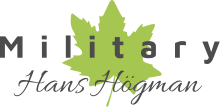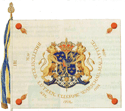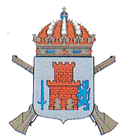

Copyright © Hans Högman 2019-05-20
Swedish Regiments of the
Allotment System - Cavalry (3)
Cavalry Regiments:
2. Swedish Regiments -
Cavalry (3)

Swedish name: Östgöta kavalleriregemente
(Andra livgrenadjärsregementet, I5)
The regiment was first established
in 1636 as the Östgöta Cavalry
Regiment. The regiment was linked
to the Allotment System in 1689.
In 1770 the regiment was organized
as a cuirassier regiment. The regiment was awarded
the rank of a Life Regiment after meritorious
achievements in the Swedish-Russian War (1788 -
1790).
In 1791 the regiment was merged with Östgöta
Infantry Regiment and the cavalry part of the
regiments received the name; The "rusthåll" Division
of the Life Grenadier Regiment
(Livgrenadjärsregementets rusthållsdivision). The
cavalry regiment was now dismounted and
organized into infantry.
In 1816 the new regiment was divided and
reorganized into the two old regiments. The former
infantry regiment received the name First Life
Grenadier Regiment (Första Livgrenadjärregementet,
I4) and the former cavalry regiment received the
name Second Life Grenadier Regiment (Andra
Livgrenadjärregementet, I5).
The regiment was disestablished in 1927. This year
the two regiments were once again merged and
received the name Life Grenadier Regiment (I4).
The cavalry regiment's history goes back to the
"fana" that was raised in the province of
Östergötland in the 1550's.
Like a many other cavalry regiments the Östgöta
Cavalry Regiment was dismounted in 1791 and
reorganized into infantry.
As a result of the Constitution adopted in 1634 the
Army was reorganized. The regiment was then
referred to as the "Östergötland and Södermanland
Horsemen" ("Östergötlands- och Södermanlands
ryttare").
The regiment was allotted with 1000 "rusthåll".
Hence, the Regiment had 1000 cavalrymen
organized into 8 companies. All of the "rusthåll"
were located within the provinces of Östergötland
and northern Småland.
Names of the Companies making up the
Regiment in 1682: Life Company, Lieutenant
Colonel's Company, Major's Company, Vadstena
Company, Vifolka Company, Skänninge Company,
Västanstångs Company and Tjust Company.
Location of the primary Garrison of the
Regiment: From 1922, Linköping. Training camp:
Malmen, Linköping.
The Official Regimental Colors: Red
Regimental Motto: Nulli Secundas (Ingens tvåa)
Companies 1833:
1.
Life Company
2.
Tjust Company
3.
Linköping Company
4.
Västanstång Company
5.
Bergslags Company
6.
Vifolka Company
7.
Skänninge Company
8.
Vadstena Company
Victorious Battle Campaigns (segernamn):
1.
Wallhof
1626
2.
Breitenfeld
1631
3.
Lützen
1632
4.
Oldendorf
1633
5.
Wittstock
1636
6.
Leipzig
1642
7.
Golombo
1656
8.
Gnesen
1656
9.
Warschau
1656
10.
Fredriksodde 1657
11.
Tåget över Bält 1658
12.
Kliszow
1702
13.
Warschau
1705
14.
Malatitze
1708
15.
Helsingborg
1710
16.
Svensksund
1790
Swedish name: Bohusläns
dragonregemente, (Bohusläns regemente,
I17)
When the Swedish-Danish War of 1657
- 1658 ended in 1658 the southern
provinces of today's Sweden became
Swedish territory. One of the provinces
was Bohuslän.
Both a cavalry unit and a dragoon unit were
established in the province in 1661. Both units
were organized into 2 companies of 150 man each.
The cavalry unit was named Bohus and Jämtland
Cavalry Battalion (Bohus-Jämtlands kavalleribataljon).
In 1670 the unit received the name Bohuslän Cavalry
Company (Bohusläns kavallerikompani).
The dragoon unit was organized into a regiment
and consisted of the two Bohuslän companies, four
companies from the province of Skåne (Swedish in
1658) and two companies from the province of
Jämtland. The regiment received the name Dragoon
Regiment of the former Dansih Provinces, also known
as Skåne-Bohuslän-Jämtland Dragoon Regiment.
In 1670 the regiment received the name Skåne-
Bohuslän Dragoon Regiment and in 1679 Bohuslän
Dragoon Battalion.
The regiment was linked to the Allotment System in
1685.
The dragoon regiment numbered 504 soldiers
organized into 8 companies. All of the "rotar" were
located within the northern part of the province of
Bohuslän. The regiment was also called the Green
Dragoons.
Besides of the units mentioned above, another
cavalry regiment was quartered in the province of
Bohuslän in 1660. This regiment was organized into 4
companies. In command of the regiment was Colonel
Rutger von Ascheberg.
In 1674 he received orders to establish an enlisted
cavalry regiment. The cavalrymen were to be
recruited in the southern part of Bohuslän and in the
province of Halland.
The new regiment was established with the
cavalrymen of his regiment plus the Bohuslän
Cavalry unit mentioned above as a base for the new
regiment.
The regiment was given the name Queen Dowager's
Mounted Life Regiment (Riksänkedrottningens
livregemente till häst).
The regiment was also called the Aschberg's
Regiment (Aschebergska regementet).
The regiment was reorganized in 1684 into an
allotted regiment with "rusthåll". The regiment
numbered 800 men with 4 companies i southern
Bohuslän and 4 in Halland.
The two companies in Jämtland were separated from
the regiment in 1675. They were replaced with two
new companies in Bohuslän the same year.
The Dragoon Regiment was merged with the 4
cavalry companies of Queen Dowager's Life Regiment
in 1720 and formed a new regiment named Bohuslän
Cavalry and Dragoon regiment (Bohusläns kavalleri-
och dragonregemente). The new regiment numbered
904 men.
The north battalion remained organized as dragoons
and the south battalion as cavalry.
In 1727 the regiment was reorganized into a
dragoon regiment and received the name Bohuslän
Dragoon Regiment (Bohusläns dragonregemente).
The Halland part of the regiment was disestablished
and transferred to the Navy's "båtsmanhåll" (the
system of providing seamen for the Navy).
In 1776 the regiment received the name Bohuslän
Light Dragoon Regiment (Bohusläns lätta
dragonregemente).
The North Battalion was reorganized into infantry with
504 "rotar" in 1776. In 1791 also the South Battalion
was reorganized into infantry. As infantry the
regiment received the name Bohuslän Regiment
(Bohusläns regemente).
All of the "rotar" were located within the province of
Bohuslän.
The Bohuslän Regiment was disestablished in 1992.
Names of the Companies making up the
Regiment: The Life Company, The Lieutenant
Colonel's Company, The Major's Company, Södernäs
kompani, Bullarens and Söderbygdens Company,
Södra Company, Tanums Company and Fräkne
Company.
Location of the primary Garrison of the
Regiment: From 1913, Uddevalla. Training Camp:
From 1692 Stenehed, from 1724 also Backamo
(south of Uddevalla), from 1770 only at Backamo.
The Official Regimental Colors: Green
Regimental Motto: Uthållighet, mod och tapperhet -
en krigsmans förnämsta dygder.
Companies 1833:
1.
Life Company
2.
Lane Company
3.
Södra Companyet
4.
Fräkne Company
5.
Stångenäs Company
6.
Bullarens Company
7.
Tanums Company
8.
Sotenäs Company
Victorious Battle Campaigns (segernamn):
1.
Lund
1676
2.
Landskrona
1677
3.
Gadebusch
1712
4.
Svensksund
1790
Swedish name: Västgöta kavalleriregemente
(Västgöta regemente, I6)
The regiment was first established in
1628 as the Västgöta Mounted
Regiment (Västgöta regemente till
häst). The regiment was linked to the
Allotment System in 1691.
The regiment received the name Västgöta and Dals
Horsemen (Västgöta och Dals Ryttare) in 1634. In
1655 the name was changed to Västgöta Cavalry
Regiment (Västgöta kavalleriregemente).
In 1792 the regiment was reorganized into a dragoon
regiment and received the name Västgöta Line
Dragoon Regiment (Västgöta linjedragonregemente )
in 1802. From 1806 the regiment carried the name
Västgöta Dragoon Regiment (Västgöta
dragonregemente).
In 1811 the regiment was reorganized once again,
now into infantry. The regiment was dismounted and
received the name the Västgöta Regiment (Västgöta
regemente, I5).
The regiment was disestablished in 1927.
The regiment's history goes back to the "fanor" that
was raised in the province of Västergötland in the
1500's.
As a result of the Constitution adopted in 1634 the
Army was reorganized. The regiment was then
referred to as the "Västgöta and Dals Horsemen"
("Västgöta- och Dals ryttare").
The regiment was allotted with 1000 "rusthåll".
Hence, the Regiment had 1000 cavalrymen
organized into 8 companies. All of the "rusthåll"
were located within the province of Västergötland. Of
those were 791 located in the county Skaraborg, 208
in the county of Älvsborg and 1 in the county of
Göteborg- and Bohuslän.
Names of the Companies making up the
Regiment: Life Company, Lieutenant Colonel's
Company, Major's Company, Södra Vassbo Company,
Älvsborg Company, Gudhem Company, Barne
Härads Company och Vartofta Company.
Location of the primary Garrison of the
Regiment: From 1916, Värnersborg.
Training camp: From 1689 Eggby ängar (north of
Skara), from 1745 Axevalla hed.
The Official Regimental Colors: Yellow and black
Companies 1833:
1.
Life Company
2.
Laske Company
3.
Älvsborg Company
4.
Barne Company
5.
Kåkind Company
6.
Vadsbo Company
7.
Guhhem Company
8.
Vartofta Company
Victorious Battle Campaigns (segernamn):
•
Skara
1611
•
Skillingahed
1612
•
Wallhof*
1626
•
Dirschau
1627
•
Stuhm
1629
•
Burgstall
1631
•
Breitenfeld
1631
•
Lützen
1632
•
Warschau*
1656
•
Tåget över Bält*
1658
•
Lund
1676
•
Gadebusch*
1712
The battle names above marked with a "*" are the
Battle Campaigns the Regiment carries in the
Regimental Colors. However, according to the Army
Colors Committee of 1892 the regiment also have
the right to carry the battle names without a "*".
In the battles of Stuhm, Burgstall and Lund the
regiment carried the Royal Colors, which means that
the King personally commanded the regiment during
these battles.
Related Links
•
The Allotment System
•
Swedish Wars
•
The Navy & the Army Fleet
•
Swedish Military Unit Designations
•
Swedish Military Branch and Unit Insignias
•
Uniforms of the Swedish Army
•
Source References
Top of page



Östgöta Cavalry Regiment
Bohuslän Dragoon Regiment
Västgöta Cavalry Regiment


























